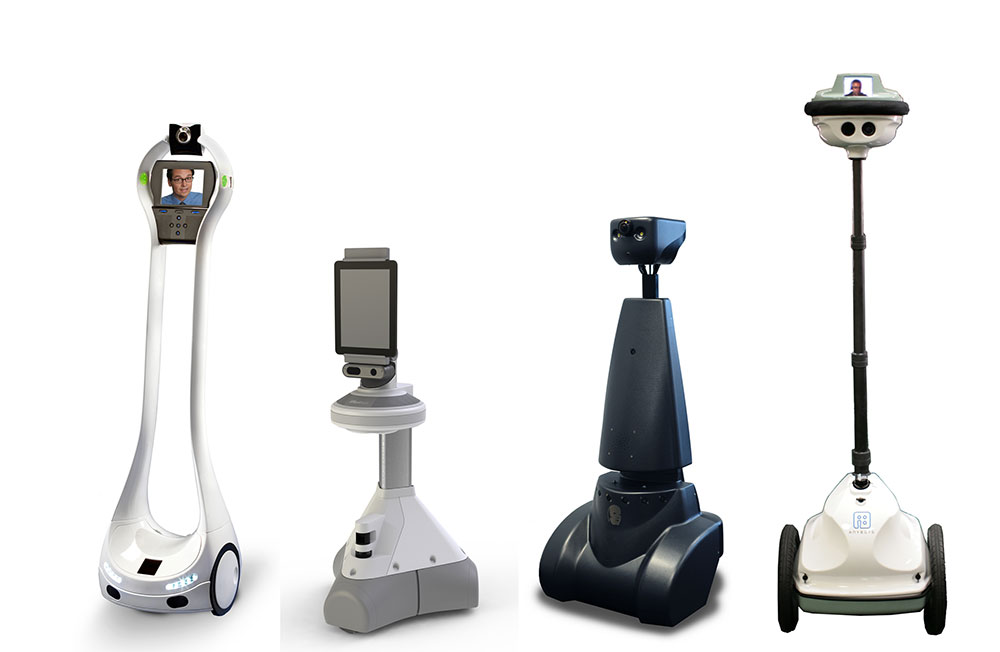Will robotic companions and caregivers soon replace humans? We’re already using some of the technologies!
By Erin Girouard
Imagine for a moment that you are a caregiver for a family member or friend who is living with dementia. Try to visualize what a typical visit might look like – a conversation about their day, a friendly game of cards, making sure they have taken their medication, or taking a quick look around the house to make sure everything is in order.
Now imagine that you are connecting with them virtually through a robot in their home. Think this is too futuristic to be a reality? Think again.
Researchers around the world are exploring the use of telepresence robots to support caregivers in looking after individuals living with dementia. These robots, comprised of a video screen on a post with durable wheels, can travel freely and are controlled from a distance over the Internet with just a click of a mouse. They enable caregivers to have a personal visit with a loved one remotely while ensuring the environment is free of any safety hazards.
Telepresence robots are just one of the many possible options currently being studied by researchers to ease the burden on caregivers. Caregiver support has become a hot topic lately – and for good reason.
The number of older adults in Canada has increased dramatically in recent years. According to Statistic Canada’s 2016 census figures, there are now 5.9 million seniors in Canada, which means that for the first time ever seniors now outnumber children in our country. There are a number of factors that are likely contributing to this historic change, such as increased life expectancy and baby boomers reaching the age of 65.
Our aging population means that there is an increased demand for healthcare services, as well as an increase in the number of people living with chronic health conditions. According to the Alzheimer Society of Manitoba, almost 20,000 Manitobans have Alzheimer’s disease or another form of dementia. By 2038, this figure is expected to rise to over 34,000.
While our healthcare system provides services to address the medical needs of these individuals, they will often require additional support from what are known as informal caregivers – family members, neighbours and friends. Many of us will soon find ourselves acting as a caregiver for a parent or family member living with dementia, and some of us are already on this journey with a loved one.
The work of caregiving is extremely important and can be fulfilling, but it can also be overwhelming at times and may lead to feelings of anger and frustration. Caregivers experience the challenges of looking after a loved one while balancing their career, education, household, family life and other commitments. Many are part of the so-called “sandwich generation”, who find themselves caring for aging parents while raising their own children. There may be little to no break in caregiving tasks, and time spent away from the individual living with dementia can be fraught with worry.
All of these emotions can take a toll on the caregiver’s physical and mental health. A recent report from the Canadian Institute for Health Information indicates that 45% of family caregivers providing care for older adults with dementia experience distress related to their role, compared to just 26% providing care for older adults without dementia.
So how can we as a society support caregivers and help to reduce their burden? Seeking out additional information and resources is a great place to start. The Government of Manitoba and the Alzheimer Society of Manitoba websites have more information on local support groups and other resources.
We can also continue to explore the role of technology, including innovations like the telepresence robot. A 2017 literature review from Griffith University found that telepresence robots have the potential to improve social connectedness for people living with dementia and their caregivers, though more research is needed to fully understand the potential role for this technology. The Vic Foundation is currently making plans to contribute to this growing body of research.
In addition to telepresence robots, there are various products available to help caregivers such as GPS bracelets to let caregivers know if their loved one has left a specific area, phone apps to track medication schedules and appointments, and video chat services to stay in touch when separated by distance. There is even technology available that can monitor the use of electrical appliances, lights, and thermostats. Some families like the peace of mind that comes with a fall detection button like Victoria Lifeline. To see if this option is right for your family, contact Victoria Lifeline at 204-956-6777.
If you are a caregiver, take some time to research the wide array of technology available that may assist you in caring for your loved one. Above all else, make time to take care of your own health and well-being. Take a short break to do something you enjoy, whether it is visiting with a friend, going for a walk, or curling up on the couch with a favourite movie or book. And don’t be afraid to reach out for help, whether it is to an organized caregiving support group or to a family member or friend.
At its heart, the act of caring for a loved one in need is one of the most valuable gifts a person can give. If you know an amazing caregiver, please take a moment to tell them how much you appreciate them. Caregivers give so generously of their love – let’s make sure we send some back in return.
Erin Girouard is the Communications & Public Relations Manager at Victoria General Hospital Foundation. This article is meant to be informational in nature and should not replace the advice of a trained healthcare professional.

